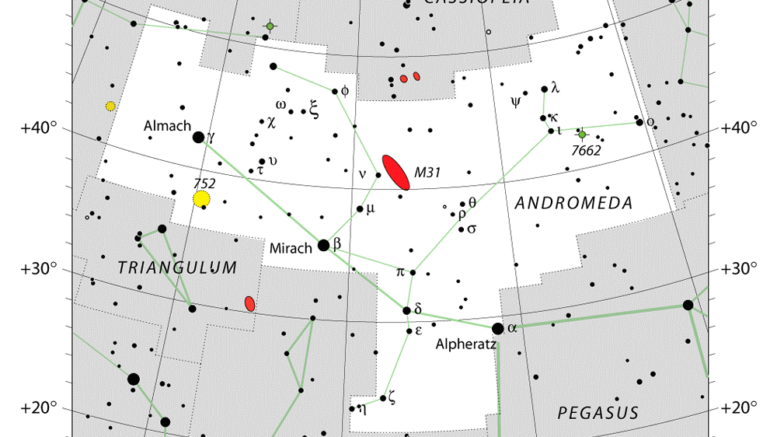The Andromeda Constellation is one of the modern 88 constellations as defined by the IAU. One of the earliest recordings of the Andromeda Constellation was the the 2nd-century Greco-Roman astronomer Ptolemy Located north of the celestial equator, the constellation is named for Andromeda, daughter of Cassiopeia, and is most prominent during autumn evenings in the Northern Hemisphere. As a result of its northern declination, Andromeda is visible only north of 40° south latitude, which means that for observers farther south, it lies below the horizon. Comparing the constellation to the size of the moon would result in the constellation being over 1,400 times the size of the full moon.
| Applicable Information | |
| Visibility In Pacific Northwest | August To February |
| Best Times To View | September, October, and November |
| Right Ascension | 23h 25m 48.6945s– 02h 39m 32.5149s |
| Declination | 53.1870041°–21.6766376° |
| Area | 722 square degrees |
| Main Stars | 16 |
| Brightest Object | α And |
| Meteor showers | Andromedids |
| Messier objects | 3 |
| Neighboring Constellations | Perseus, Cassiopeia, Lacerta, Pegasus, Pisces, Triangulum |
The Name
In traditional Chinese astronomy, nine stars from Andromeda, along with seven stars from Pisces, formed an elliptical constellation that either represented the foot of a walking person or a wild boar.
Andromeda did have some origins in Babylonian astronomy, and was known by the Greeks. The English name means “the Chained Lady” or “the Chained Woman” in English. It was known as Mulier Catenata, “chained woman” in Latin, and al-Mar’at al Musalsalah in Arabic
Stars
The brightest star in the constellation is a binary star that typically was counted as a part of Pegasus. The star is named Alpha Andromedae. It is worth noting that the binary star Gamma Andromedae is really colorful and a popular target for amateur astronomers. Beta Andromedae is a red giant that is visible to the naked eye. The constellation’s most obvious deep-sky object is the naked-eye Andromeda Galaxy, known as M31, also called the Great Galaxy of Andromeda. The Andromeda Galaxy is the closest spiral galaxy to the Milky Way and one of the brightest Messier objects. Several fainter galaxies that lie within Andromeda include M31’s companions M110 and M32 and the more distant NGC 891. Another object worth noting is the planetary nebula called the Blue Snowball Nebula, which isvisible in a telescope as a blue circular object.
Make sure to check out other articles on the site, including a brief introduction to constellations, other constellation articles, and more!

Be the first to comment on "Andromeda Constellation"